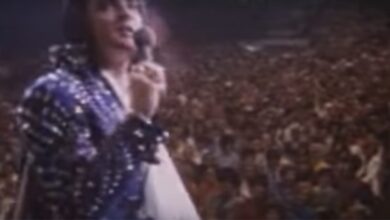Do You Recall This Well-Known 1950s Dance
In February 1958, an infectious dance craze ignited a wave of excitement across American high school gyms and sock hops, encapsulating the vibrant spirit of the era and embodying the carefree energy of rock ‘n’ roll’s early days. This dance was none other than “The Stroll,” a captivating line dance that quickly became synonymous with youthful exuberance and spontaneous joy. Originally rooted in African American communities, “The Stroll” captured the imagination of teens nationwide, largely due to its exposure on television programs like Dick Clark’s “American Bandstand.” Through this platform, young viewers across the country were not only introduced to the dance but inspired to take it up at local gatherings, transforming it into a national phenomenon.
“The Stroll” went beyond being merely an engaging dance; it became a cultural movement reflective of the diverse social dynamics of the 1950s. The format of the dance was simple yet effective: participants formed two lines facing each other, creating a lively aisle in the middle. Couples would then take turns strutting down this center aisle, embodying the rhythm of the accompanying music while adding their unique flair to their movements. This interactive setup allowed for group participation while simultaneously encouraging individual expression, resonating powerfully with a generation of young people who were beginning to establish their identities amid a rapidly changing societal landscape.
Accompanying this exhilarating dance was the song “The Stroll,” performed by the Canadian vocal group The Diamonds. Renowned for their rich harmonies and infectious doo-wop melodies, The Diamonds played an integral role in popularizing “The Stroll” and bridging the gap between different musical genres and cultural backgrounds. Their rendition became more than just a musical hit; it morphed into the anthem of a burgeoning youth culture. Lead singer Dave Somerville, with his powerful baritone voice, became the definitive voice of the dance craze, captivating dancers and listeners alike with his smooth, melodic phrasing that seemed to beckon them to the dance floor.
The meteoric rise of “The Stroll” turned it into a dance floor staple at social events of the time, where teenagers eagerly embraced its charm. The dance resonated widely, serving as a cultural bridge that cut across racial and social divides during a period marked by significant segregation in the United States. Its straightforward nature made it accessible to many, while its inherent coolness made it irresistibly appealing to young people seeking a sense of belonging and identity. Clad in their best outfits and full of youthful optimism, teenagers flocked to dance floors, eager to partake in this exciting new trend and display a confidence that mirrored the buoyant spirit of post-war America.
As “The Stroll” surged in popularity, it became emblematic of a generation’s desire to express themselves and revel in the newfound freedoms suffusing the 1950s. With its increasing presence on television and its infectious sound permeating the airwaves, “The Stroll” solidified its place as a memorable component of American pop culture. It represented not only a dance but also a moment in time where music and youth culture intertwined to shape the lives of countless individuals. The legacy of “The Stroll” endures as a vivid symbol of an era marked by innocence, joy, and a collective longing for connection.
Adding depth to the understanding of this phenomenon, we can look into the lives of the individuals behind the music. The Diamonds, formed in 1953, saw their lineup change through the years but maintained a focus on harmony and vocal blending that became their hallmark. Dave Somerville, the original lead singer, was born in 1933 and raised in a musically inclined family. His smooth tenor and charismatic stage presence helped propel The Diamonds to stardom, contributing significantly to their success with hits like “Little Darlin'” and “The Stroll.” The group, reflecting the popular doo-wop genre’s influences, was a bridge between rhythm and blues and the emerging rock and roll landscape, crafting a sound that resonated with a diverse audience.
Their influence extended far beyond just one song or dance. The Diamonds were pivotal in introducing a clean-cut, accessible image to rock ‘n’ roll, which aligned well with the tastes of mainstream America. They played a crucial role in making African American music palatable to a broader audience during a time when cultural shifts were beginning to permeate the social fabric of the nation. Their work was groundbreaking, laying the foundation for many future artists who would follow suit, seeking to blend genres and connect with listeners across barriers.
The impact of “The Stroll” was felt beyond the dance halls and school gyms. It became a form of social expression, a way for young people to assert their identities and rebel against the older generations’ more conservative social norms. As the television age dawned, the visibility of such dances introduced a new level of intimacy and connection in American youth culture, allowing individuals nationwide to share in communal experiences through music and dance.
Even today, “The Stroll” stands as a testament to the power of music and dance to forge connections. Its simplicity and infectious spirit remind us of the joy that music can bring, as communities come together to celebrate life through movement and rhythm. The essence of “The Stroll” endures in popular culture and continues to inspire new generations, as echoes of the past intertwine with modern expressions of creativity and communal joy. The dance’s legacy, much like the harmonies of The Diamonds, reflects a shared spirit that transcends time, inviting all to celebrate the unifying power of rhythm and melody.
?si=CbHsPwTM-VodZAIG





